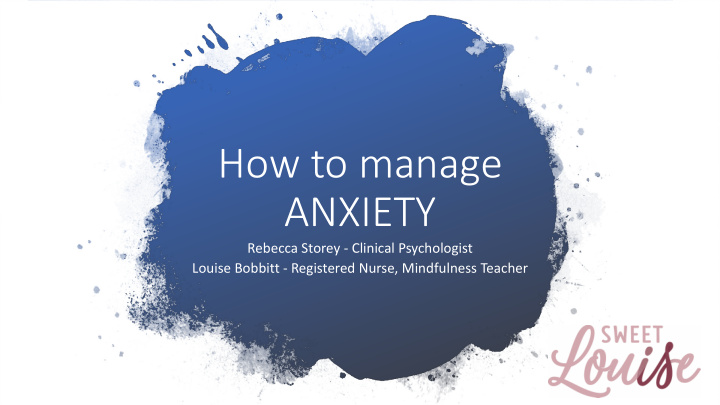



How to manage ANXIETY Rebecca Storey - Clinical Psychologist Louise Bobbitt - Registered Nurse, Mindfulness Teacher
When we are facing a crisis of any sort, fear and anxiety are inevitable Normal, natural responses to Not unusual challenging situations infused with danger and uncertainty.
• Hearing the news • On going medical appointments, treatment etc • Managing symptoms and treatment side Common effects • Changes to career/job/finances Stressors • Changes in relationships • Living with uncertainty
Anxiety We can think of anxiety as a CONTINUUM • Mild, everyday stress that allows us to continue functioning, and might even be useful to get us motivated • Moderate, a heightened feeling that is noticeable to others but is still manageable. • Severe, it impacts how we live our lives and at times can leave us unable to cope with daily routines and living well. This Photo by Unknown Author is licensed under CC BY-SA-NC
• The fight - flight - freeze response is your body's natural reaction to danger. It's a type of stress response that helps you react to perceived threats, like an oncoming car or growling dog. The response instantly causes hormonal and physiological changes Threat response
Brain changes Two parts of the brain are key players in the experience of anxiety. Amygdala is believed to be a communications hub between the parts of the brain that process incoming sensory signals and the parts that interpret these signals. It can alert the rest of the brain that a threat is present and trigger a fear or anxiety response. Hippocampus is the part of the brain that encodes threatening events into memories. Emotional memories stored in the central part of the amygdala may play a role in anxiety disorders involving very distinct fears, such as fears of dogs, spiders, or flying.
Adrenaline and Cortisol tell our bodies that there’s something scary on the horizon, and we need to run away. Designed to help our bodies cope with danger: they increase our awareness and improve our reflexes. Stress But when they flood through your brain in a normal, only slightly Hormones frightening, situation — like when preparing for a meeting, stressful airplane ride, or a thunderstorm — they create anxiety. To make matters worse, an increase in stress hormones can cause our bodies to release even more stress hormones, until we have a cavalcade of worries. If this goes on for too long, our baseline anxiety is likely to increase
Thoughts ‘What if…’ “If I… Body Emotions Stress Anxiety response Behaviour Fight/flight /freeze
When we experience emotional storms, unhelpful thoughts and painful feelings let’s not get caught up in the storm but focus on staying anchored. F ocus on what you can control What to do A cknowledge thoughts and feelings when anxiety C oming back into our body flares E ngage in what you are doing
A cknowledging thoughts C E
C oming back into our body Slowly pushing your feet hard into the floor. Slowly straightening up your back and spine; if sitting, sitting C oming back upright and forward in your chair. Slowly pressing your fingertips together into your Slowly stretching your arms or neck, shrugging your shoulders. body Slowly breathing
E ngage in what you are doing Get a sense of where you are and refocus your attention on the activity you are doing. • Look around the room and notice 5 things you can see. • Notice 3 or 4 things you can hear. Engage • Notice what you can smell or taste or sense in your nose and mouth • Notice what you are doing What can I do right now - no matter how small it may be - that improves life for myself or others I live with and whatever the answer is – do it, and engage in it fully
F = Focus on what’s in your control A = Acknowledge your thoughts & feelings C = Come back into your body E = Engage in what you’re doing This Photo by Unknown Author is licensed under CC BY SA
The most beautiful people we have known are those who have known defeat, known suffering, known struggle, known loss, and have found their way out of the depths. These persons have an appreciation, a sensitivity, and an understanding of life that fills them with compassion, gentleness, and a deep loving concern. Beautiful people do not just happen.” - Elisabeth Kübler-Ro ss Self compassion
“Within you, there is a stillness and a sanctuary to which you can retreat at any time and be yourself.” Hermann Hesse, Siddhartha If you need someone to talk to, please contact your Sweet Louise Support Coordinator Angela, Jenny, Kendra, Lesley, Nadine, Nicki, Tracy or call us on 0800 11 22 77

Recommend
More recommend